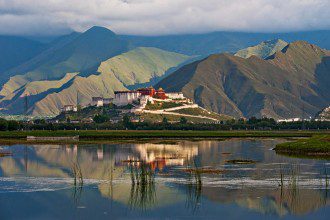| Online: | |
| Visits: | |
| Stories: |

| Story Views | |
| Now: | |
| Last Hour: | |
| Last 24 Hours: | |
| Total: | |
Tantra, Mantra, Yantra and Tibet – Where Imperialism and Spirituality Collide
Contributing Writer for Wake Up World
The word ‘tantra’ signifies confluence and integration; a fusion. Sanskrit for “loom”, a device which weaves together string into cloth, tantra is an ancient word with many properties and uses; it has been variously used to describe the knots of strings weaved together in a rug, and the cord on which sacred mala bead necklaces were strung. (Mala beads are Tibetan prayer necklaces of 108 beads used to assist mentally or vocally repeating a mantra 108 times.) Today the word tantra is often used in reference to the union of lovemaking.
More broadly, however, tantra notes a mutually accepted connection, a tied knot of intertwined being, like lovemaking, but not necessarily beginning with or limited to it. Humanity itself is a tantra; a fused weaving knot or many strings.
Essentially, tantra is spiritual understanding of the relationship between individuation and connection. An ancient spiritual philosophy preceding both Buddhism and Hinduism, tantra represents integration, unifying the macrocosm with the microcosm, the universal and the individual, the feminine and the masculine, the yin and the yang. It can also refer to integrative knowledge and its continuation and building through the interaction of teacher and student, signifying union and fusion; the acceptance, integration and transmutation of knowledge between individuals, like the string of life.
Tantra should not be confused with yantra yoga from Tibet, or yantras, the sacred geometric symbolism, just as the practice of yoga should not be confused with being simply asanas or physical postures. Yantra yoga is one of the oldest forms of yoga and because of the environmentally foreboding nature of Tibet and the varying secretive cultures of most meditative movements, it is said to be one of the purest and least altered forms of yoga. Yantra yoga concentrates on moving into and out of asanas with the breath, as opposed to being in a position for multiple breaths. However tantric ideas are metaphysical; the merging of the physical and spiritual. In essence, Tantra is the integration of yantra (a philosophy and visual symbol), mantra (oral communication) and mudra (meaning “gesture”, a physical positioning) — each of which is important intertwined aspect of yoga, and life.
Previous articles by Ethan Indigo Smith:
- The Common Origin of Religions and Theology
- Mutually Agreed Peace: Ending The Doctrine of Perpetual War
- The 5 Tibetan Rites of Rejuvenation: 108 Movements to a Meditative Mind State
- Idiots, Zealots, Elitists and Patriots: The Four “Wise Monkeys” of Modern Society
- Marijuana Prohibition and The Suppression of The Divine Feminine
- Meditation 108: A Guide to Meditating for the Infant Practitioner
- Is Matriotism The Future of The Divine Feminine? (w/Andy Whiteley)
- A Little Green Revolution: the Rainbow Warriors will Heal the Earth Mother
- Why Governments Promote Deadly Nuclear Energy and Ban Beneficial Hemp
- Hate: The Ultimate Social Control Mechanism
- The Healing Benefits of Tapping and Tai Chi
-
Follow Wake Up World On…
[FACEBOOK]: http://www.facebook.com/joinwakeupworld (An interactive community of over 2,800,000)
[PINTEREST]: http://pinterest.com/wakeupword/
[TWITTER]: http://twitter.com/joinwakeupworld
[YOUTUBE]: http://www.youtube.com/joinwakeupworld
[GOOGLE PLUS]: https://plus.google.com/112452105795129310867/posts
[WEBSITE]: http://wakeup-world.com




